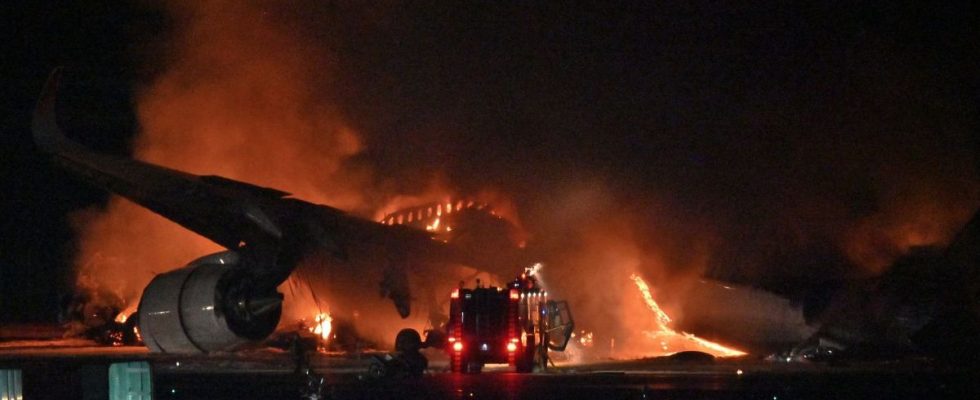Investigators will look this Wednesday into the spectacular ground collision between two planes that occurred Tuesday at Tokyo-Haneda airport (Japan), which left five people dead. All 379 passengers and crew members of Japan Airlines flight JAL516 survived, having been evacuated after the airliner collided during landing with a Japanese Coast Guard Dash 8, which was preparing to take off. The Japanese company claims that its Airbus, destroyed by flames during the accident, was authorized to land.
The impact caused a large explosion and the JAL plane caught fire before coming to rest further away. It burned to the ground after all its occupants were evacuated using inflatable slides at the front. Fourteen people were slightly injured, according to firefighters. “It’s a miracle that we survived,” commented a 28-year-old passenger, quoted by the daily Nikkei after the accident.
The passenger evacuation procedure carried out in an “impeccable” manner
“Airlines must be able to evacuate all passengers and crew members from a plane within 90 seconds,” said Doug Drury, an aviation expert at the University of Central Queensland in Australia. This rule set by the International Civil Aviation Organization (ICAO) obliges aircraft manufacturers to design their aircraft in such a way as to be able to meet this evacuation time, and on-board personnel train regularly for this purpose. added this expert.
It is a “complicated” procedure but it was carried out here in an “impeccable” manner, praised Doug Drury. “A key factor is that no one here has tried to take their hand luggage! There have been several fatal accidents in the past because someone had taken their luggage out of the cabin, thus slowing down the evacuation of everyone, he recalled.
However, five of the six occupants of the coast guard plane died. Only the captain managed to evacuate, although seriously injured. They were preparing to take off to provide basic necessities to those affected by Monday’s gigantic earthquake in the Ishikawa department (central Japan), which left at least sixty dead.
Pilot of Coast Guard plane says he was cleared to take off
Did the plane JAL516, which arrived from Sapporo (northern Japan), have permission to land? Asked during a press briefing Tuesday evening, a Japan Airlines official replied: “From what we understood, it had been given. »
Radio exchanges from the Tokyo-Haneda control tower seem to support this version. “Japan 516, continue your approach,” we can hear from an air traffic controller at 5:43 p.m. local time (8:43 a.m. GMT), four minutes before the collision. Conversely, an air traffic controller would have asked the coast guard plane to wait away from the runway, according to the NHK television channel citing a source within the Japanese Ministry of Transport. But according to a coast guard official also mentioned by NHK, the surviving pilot of this aircraft declared just after the accident that he had obtained permission to take off.
A team of French experts from the BEA expected this Wednesday
Japan Airlines, the Coast Guard and the Japanese Ministry of Transport are currently refusing to make further official comments, citing the ongoing investigation. A team of experts from the French Bureau of Investigation and Analysis (BEA) for Civil Aviation is due to arrive in Japan on Wednesday, given that the JAL plane was an Airbus A350-900, produced in Toulouse. Airbus also announced that it would send a “technical assistance” team to help the investigation by the Japanese Transportation Safety Board (JTSB).
Airport traffic remains disrupted on Wednesday, especially for domestic flights, with numerous cancellations and delays, according to its website.

